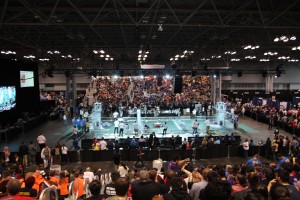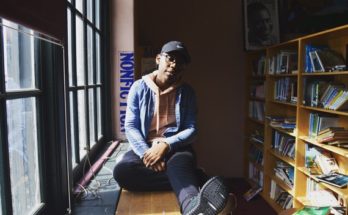At 4:30 p.m. on any given weekday, one corner of Brooklyn’s Pathways in Technology Early College High School (P-TECH) buzzes, literally, with activity. One Wednesday last month, close to 20 students drifted in and out of two adjacent classrooms on the building’s fourth floor, rummaging in the supply closet attached to algebra teacher Brian Lewis’s classroom, bringing an assortment of nails, wood and wires back to the vacant room next door.
A chorus of power drills and table saws whirred in the background as two math teachers puzzled over a wooden
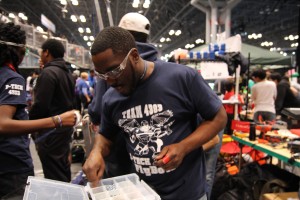
contraption in the center of the room.
“I’m just not sure…” Lewis, the algebra teacher, trailed off.
“Yeah. We’ll try it and see,” said Ben Gould, another math teacher, pulling one of the rubber tubes that controlled the structure’s movement.
Clad in safety goggles, sturdy brown boots and work gloves, Lewis moved easily around the room, checking in with the team. His average height makes him a bit shorter than many of his students, and Lewis has a way of vanishing in the crowd of teens he is instructing, only to emerge, distinctly the adult in the room with his dark, close-shaven facial hair and tidy buzz cut.
He adjusted his goggles before walking back across the hall to refocus his attention on searching the supply closet–what for, it wasn’t clear.
Nestled into two floors of the Crown Heights building that once served as Paul Robeson High School for Business and Technology, P-TECH has offered a uniquely science-focused curriculum with ties to industry to underserved teens in its short five-year lifespan. It’s a school that has been reinventing itself since 2011, under the spotlight of the city and the Obama White House, for its promise to offer not just a high school diploma to city teens, but a college associate’s degree as well: Creative building is in its DNA.
As Lewis left the room, robotics team veteran Cierra Copeland looked up from the blueprints she had been poring over in the corner to yell across the room at a group of boys clustered around the table saw. The loud buzz of the saw died down for a few seconds as she instructed them on how to finish the cut they were making.
Near the team at the saw, two pensive students tinkered with a set of wires, asking after Lewis, who had already left the room. As he strode out, he had predicted the inevitable flurry of questions that would crop up, confessing: “I feel like my head is in a million different places. Everybody comes to me with their questions because I’m the coach, but I don’t know everything!”
It may sound like a state of mild chaos – and the teachers on hand would be quick to agree – but this is just another meeting of the P-TECH Robotics Club.
—-
Robotics has been an integral piece of the 500-student school’s extracurricular offerings since it opened its doors. Founding principal Rashid Davis was eager to launch the program, and Lewis was quick to volunteer himself as coach of the team. Despite not having much direct experience, Lewis was interested in learning the ins and outs of programming and building a robot, and in encouraging kids to do the same.
“I’m learning this just like the kids are learning,” he said, “But, I think I think faster than the students, so I can learn it and then show them.”
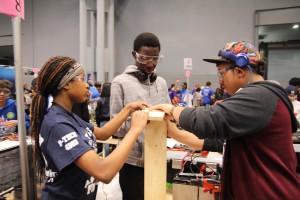
The end goal is the FIRST Robotics Competition, and the process of building the robot is a feat of creative stamina. Nearly two months of daily brainstorming, constructing and re-strategizing, plus hours spent agonizing over various road blocks along the way culminate in a marathon day of competition. It’s time that Lewis doesn’t think twice about devoting to the project each year; he knows from experience that the robot will need all the time he can give it.
The first year P-TECH competed in the FIRST Tournament was hugely challenging, according to Lewis. The team did not finish the bot until the day of the competition itself, and the first time they drove it out on the playing field, “the robot basically fell apart,” he said.
“Nuts and bolts were everywhere,” he added. “There were chains on the left and right; I think both sides popped.”
But by the next year, Lewis found that he and the students had learned. Not only did the robot stay intact throughout gameplay, but the team also placed the highest it has in its history. It’s that kind of progress, coupled with the suspense and excitement of the competition itself, that makes the annual struggle fun.
“It’s like building a plane while taking off,” said Lewis. It’s both exhilarating and a little nerve-wracking, a test of your ability to innovate and improvise, and never fully finished. “A lot of robotics is figuring it out.”
Much like the process of building a unique school from scratch.
Principal Davis had good reason to pursue robotics off the bat: An activity that focused on the integration of creativity with technology, engineering and physics was in line with the goals of the new high school itself. P-TECH was founded on the principle that high school graduates should be not just college-ready but also career-ready. The work focus has students as young as 9th and 10th grade interning with local tech companies and experiencing applied science and technology in the classroom.
For both Lewis and the students, robotics has become a way to connect to the school’s mission – what drew them to P-TECH in the first place. Each year, FIRST Robotics lays out a new challenge, only formally announced six weeks prior to the competition. That means teams can only begin building their bots six weeks before the big day. What may sound like a recipe for extreme stress to some, though, is half the fun to the participants:
“I like creating things – building something from scratch,” Lewis said. “I’m not an engineer, I’m not an expert at robotics. I wouldn’t have had this opportunity anywhere else.”
It’s an apt analogy for his path to P-TECH. After graduating from New York University in 2011 with his masters in Math Education, the 31-year-old New York native found he was only able to apply to new schools for work; the city had called for a hiring freeze on established institutions. Attracted to P-TECH’s science focus, Lewis applied for the unfilled algebra teaching position and was hired within the week. He has been at the school–teaching and coaching robotics–ever since.
His eagerness to jump in with both feet may have led him to the school and the team, but it’s Lewis’s calm, measured demeanor and easy-going personality that have kept him here.
“His whole aura is good,” said Gould, who acts as a secondary faculty adviser to the robotics club, helping out during team practices whenever possible. “He does a good job of leaving as much as he can to the kids. I have trouble with that sometimes.”
It’s Lewis’s spirit that led senior Erica Wright, a robotics team captain this year, to the club. Although she has never had a class with Lewis, “I always saw him in the hallway and just said hi because he seemed like a cool teacher.”
She is good friends with Spencer Jones, a recent graduate who still mentors for the team. And once Spencer got her involved last year, Erica became committed to coming back and giving it her all, in part because of Lewis.
“Everything is always laughs but he can also be serious. It’s cool to be able to work but also have fun at the same time,” Erica said.
Fostering an environment of fun and focus seems to come naturally to Lewis, whose classroom is generally open to students, not just after school but during the day as well. On occasion, his free period is swallowed up by the scrum of students that camp out in his classroom during the day.
“It’s nice that kids like you and stuff, but it’s also a pain because they bother you a lot,” he joked, “It’s a Catch-22!”
But despite some feigned aggravation, he wants to be a support for the kids.
“I enjoy being a mentor to them,” he said, “And when students come back later on and say, ‘you helped me so much.’”
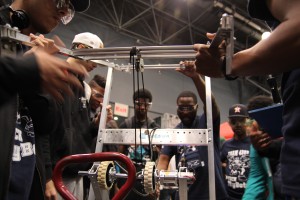
Lewis and the team have helped each other, and evolved together, in the past few years.
In large part, the program was initially made possible by P-TECH’s partnership with the New York City College of Technology, which lent the robotics program workspace for three years as well as graduate student mentors as support for the nascent team. Last year, Lewis decided the team would try to stand more independently. He opted to bring construction in house, cutting down the transportation time to the college campus for himself and the students, and also recruited two other teachers at the school for help in place of the graduate students (Gould and Scott Pecorino, a physics teacher on campus).
During the last year at the college, the team only had one graduate student mentor helping out. “It was kind of rough,” said Lewis, “and then we decided to do our own thing, which was also rough.” With more responsibility resting on him, Lewis has had to get resourceful: “Many trips to Home Depot. Lots of trips to Home Depot,” plus older students who have been able to stand in and guide the process have been instrumental to the program’s independence this year.
“The kids who are really into it,” he said, “They watch, they learn, and then they come back and can be mentors.”
Mentors like Spencer and Cierra and student captain Erica fill this supplementary role for the younger students. And if Lewis has passed on his technical ingenuity, his older students have also absorbed his hands-off teaching style.
The team has to start trying out ideas without knowing what will work and what won’t.
“There’s no instruction manual for the robot,” Lewis said. “We are creating the instructions.”
It’s his matter-of-fact approach to the inevitable trials and errors of the process that have likely rubbed off on students. Lewis has the rare ability to command a room without yelling, without being overbearing. At team meetings, in the midst of the noisy, crowded room and the air of disorder, he jokes with his students, maintains his affable nature, and they can’t help but follow his lead.
“You build one thing, you think it will work, but then you see a flaw and you have to take it apart and start all over,” Erica said, “Nothing is ever set in stone.”
Tenth-grader Michael McLean, who is the primary coder on the team this year (Java is required to program the robot to take instruction from the remote control that allows students to “drive” it during the competition), enjoys the freedom of the club.
“You kind of work with them,” he said ,”you don’t really work for them.”
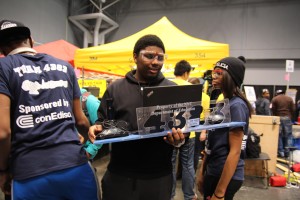
For instance, Michael spends some of his free periods tackling bot problems in the supply room, with Lewis checking in intermittently when he can. Once, last year, they spent several hours troubleshooting why the robot was not responding to code, writing and rewriting it to make it work, only to find out the code was fine and it was merely a connection issue preventing the bot from reading the code. Collaboratively, teacher and students are able to push forward.
Older students describe modeling their own methods after Lewis’s.
“I enjoy teaching but it can be frustrating because sometimes you want to just tell them to do it and let them figure it out, but they don’t necessarily know how,” Erica said.
So, like Lewis, she has found she and the other captains must step back, instruct as necessary, and allow the newer students to the program the opportunity to struggle and figure things out on their own.
Ninth-grader Morsaline Mozahid is one such rookie bot-builder this year.
“At first it was really tough,” he said, “I didn’t know how to use the machines and I was afraid that I was going to mess up.”
Within a few weeks, however, Morsaline has grown more confident in his ability to take on smaller tasks like taking measurements and cutting wood pieces for the robot’s body.
As the students grow into new roles as problem solvers, the pressure builds. This year’s FIRST Robotics Competition requires the bots to play a game called Stronghold, in which teams go head to head, each trying to launch an attack on their opponent’s tower by surmounting obstacles in the way and then shooting balls into the tower windows. The tournament lasts an entire weekend, and each team faces off against a number of others throughout the day, giving everyone a chance to tweak their strategy and their bots as the competition wears on.
“I know it’s funny to think about a robotics event getting pretty wild, but,” said Gould, “it’s a pretty boisterous affair.”
This year’s March 12 – 13 competition was an intense one; the game of Stronghold is complicated and required a lot of set-up between matches, which made the event run behind. Despite two rounds with technical glitches, however, P-TECH’s team (this year dubbed the FlyBots) finished 37th out of 66th. Last year, said Lewis, they finished 60th out of a similar number, so this is a marked improvement – and unlike year one, the finished robot stayed intact on the field. The FlyBots – like Lewis and the school – are taking off.
